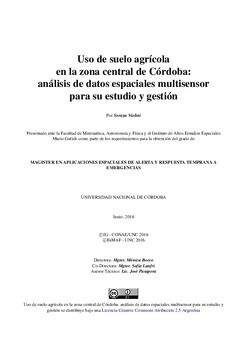| dc.contributor | Lanfri, Sofía | |
| dc.contributor | Pasapera Gonzales, José Jesús | |
| dc.contributor.advisor | Bocco, Mónica de Lourdes | |
| dc.contributor.author | Violini, Soraya Noemí | |
| dc.date.accessioned | 2016-06-28T16:08:22Z | |
| dc.date.available | 2016-06-28T16:08:22Z | |
| dc.date.issued | 2016-06 | |
| dc.identifier.uri | http://hdl.handle.net/11086/2753 | |
| dc.description | Tesis (Magister en Aplicaciones Espaciales de Alerta y Respuesta Temprana a Emergencias)--Universidad Nacional de Córdoba, Facultad de Matemática, Astronomía y Física, 2016. | es |
| dc.description | Maestría conjunta con el Instituto de Altos Estudios Espaciales "Mario Gulich"-CONAE | |
| dc.description.abstract | La presente tesis, tiene como objetivo principal la identificación y análisis de cultivos de verano a través del uso de imágenes satelitales ópticas y de radar, en el centro de la provincia de Córdoba. Se utilizaron imágenes procesadas y calibradas de los sensores SPOT, Landsat y COSMO SkyMed. Para todas las imágenes, se presentan las firmas espectrales y sus variabilidades en las longitudes de ondas del espectro visible y del infrarrojo como una primera aproximación que permita inferir el tipo de cobertura de suelo y, en los cultivos, su comportamiento y estadios fenológicos. Para la clasificación se aplicaron algoritmos de redes neuronales y se modelaron datos radar mediante el método de distancia estocástica de Hellinger. Se obtuvieron muy buenos resultados con imágenes ópticas, identificando cada cultivo en sus diversos estadios fenológicos con todos los métodos utilizados. A partir de imágenes provenientes de sensores SAR, se identificaron diferencias estadísticas y estocásticas, aunque los resultados en polarizaciones VV y HH no mostraron una clasificación estadísticamente válida para el área de estudio. | es |
| dc.description.abstract | This thesis, has as its main objective the identification of summer crops through the use of optical and radar satellite images in the center of the province of Cordoba. Processed and calibrated images from SPOT , Landsat and COSMO Skymed sensors were used. For all images, the spectral signatures and their variability in the wavelengths of the visible spectrum and infrared were presented, as a first approximation that allows us to infer the type of land cover and, in the crops, their behavior and phenological stage. For classification were implemented algorithms of neural networks and radar data were modeled using the method Hellinger stochastic distance. Very good results with optical images were obtained, identifying each crop in its different phenological stages with all the methods used. From SAR sensor images, statistics and stochastic differences were identified, although the results in VV and HH polarizations showed no statistically valid classification for the study area. | |
| dc.language.iso | spa | es |
| dc.rights | Creative Commons Atribución 2.5 Argentina | |
| dc.rights.uri | https://creativecommons.org/licenses/by/2.5/ar/ | |
| dc.subject.other | Imágenes ópticas | |
| dc.subject.other | Imágenes SAR | |
| dc.subject.other | Agricultura | |
| dc.subject.other | NDVI | |
| dc.subject.other | Redes neuronales | |
| dc.subject.other | COSMO SkyMed | |
| dc.title | Uso de suelo agrícola en la zona central de Córdoba: análisis de datos espaciales multisensor para su estudio y gestión | es |
| dc.type | masterThesis | es |





